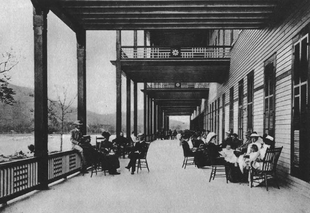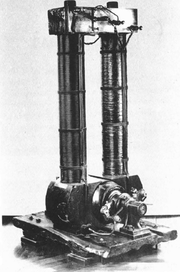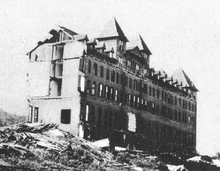Prospect House (Blue Mountain Lake (New York))

Prospect House was a 300-room luxury resort hotel at Blue Mountain Lake in New York state in the United States that opened in 1882. It was patronized by wealthy Americans and others from around the world as well. It was the largest hotel in the Adirondacks at the end of the nineteenth century. The hotel had the most modern state-of-the-art luxury conveniences for its guests, including the world's first installed incandescent electric lighting in all the guest rooms. Thomas Edison oversaw the electrical engineer on all the electrical items for the hotel during its construction, including the installation of two dynamo electric generators at the premises. It had a short operating season and high overhead costs that ultimately caused it to go out of business by 1903.
Background history


Prospect House was a hotel construction project where the guest lodging of Ordway House stood, named after the prospector James Ordway and his wife Mary. Ordways' guest house was built in 1877 on a peninsula point protruding out into Blue Mountain Lake called Prospect Point. It was a two and a half story wood frame structure and was just west of the village of Indian Lake. It could accommodate thirty guests. It received a new name of American House in 1879 and was sold to Frederick C. Durant, associated with a sugar-refining business in New York City. Durant's uncle was railroad financier Thomas C. Durant who had an interest in Adirondack developments. The younger Durant thought that concept was most interesting, so planned a 300-room luxury hotel on the tract of land he purchased from the Ordways.[1][2]
The foundation construction started for the new hotel in the autumn of 1880. In the spring of 1881 Durant set up a saw mill at the construction site for the boards needed for the new hotel. The design of the new hotel was a T-shaped building, with the top part 255 feet long as the front of the hotel facing the lake. The leg of the "T" was 158 feet long connected at the rear to Ordway's original guest house. A veranda porch twenty feet wide and 370 feet long ran along the front and sides of the building. The general architecture resembled the Grand Union Hotel at Saratoga Springs, New York.[3]
The six story Queen Anne style hotel opened in the summer of 1882. The largest suites of the new hotel were on the main floor. The hotel had a restaurant, bowling alley, billiard room, shooting gallery, golf, and lawn tennis for guest amusements. For convenience the hotel facilities were a barber shop, a mail room, a telegraph office, and a library. The hotel had a physician's office and a pharmacy for medical issues. There was an orchestra that performed daily to the 500 guests at the hotel.[4]
The hotel's outside appearance was not considered good looking, but the inside was posh and luxurious.[5] It was the largest hotel in the Adirondacks at the time. It was built some thirty miles from the nearest railroad as how the guests first traveled there. They then transferred to a stagecoach that took them to the lake where they took a boat to Prospect Point where the hotel was located.[6]
The three hundred rooms had running water and steam heat. There were no radiators nor valves involved with the steam heat. It came from the steam pipes that ran through the guest room. The pipe was encased in a wooden box with hinged covers. The guest would open the box cover when the room was cold and close it when the room got warm.[3] The hotel also came with a steam elevator, a bowling-alley, a shooting gallery, a billiard room, a telegraph office, a deer corral, a windmill, a water tower, and a boathouse.[7]
Thomas Edison oversaw the electrical system put in the hotel. G. W. Waters became the electrical engineer. Edison and Waters designed the electrical system for every room to have incandescent electric light from when the hotel opened in 1882. It was the first hotel anywhere to be equipped with electric lighting in the all the guest rooms.[6][7][8][9] The electricity came from two Edison dynamo electrical generators at the premises.[7][10] The dynamos were given the name of the 'long-waisted Mary Ann' because of its construction appearance of two long poles which stood upright that were about five feet high.[11]
Guests
The guest register shows that some of the wealthiest stayed at the Prospect House year after year. Among the names are Schuyler, Fairchild, Osborn, McAlpin, Noyes, Hoppin, Coggeshall, Pruyn, Sage, Cluett, Lippincott, Crocker, van Rensselaer, Cleveland, Breslin, Colt, Grace, Burden, Polk, Huntington, Whitney, Conkling, Griswold, Tiffany, and Vanderbilt.[12] Most guests were Americans that came from the Mid-Atlantic states, however on occasion visitors came from London, St. Petersburg, Tokyo, and main land Europe. In 1893 Cristobal Colón y de La Cerda, 14th Duke of Veragua of Spain, a lineal descendant of Christopher Columbus, was a guest while visiting America to commemorate Columbus' 1492 discovery.[13]

Demise
The demise of the Adirondack resort was from several causes. One was from high overhead costs of running such a luxurious hotel for a short season in the summer months. Another cause was from the lack of easy access to the hotel, as the Delaware and Hudson Railway withdrew its sleeper service from New York City to North Creek, New York, which had saved several hours in travel time. Competition of additional hotels in the Adirondacks took away many of the former guests, when they went to these newer hotels that were easier to get to. There was a couple of cases of typhoid fever in the area that stopped many guests from coming. Another factor was the recession of 1893, when Durant borrowed two large amounts from his brother Howard to stay in business. Ultimately his brother took over the management of the hotel in 1897 to cover the mortgages he furnished. Howard renamed it Hotel Utowana. Due to the overhead costs, lack of easy transportation, and poor management the hotel declined in business and finally went out of business in 1903. The furnishings were sold off and it was torn down in 1915.[14]
References
- ↑ Tolles 2003, p. 77.
- ↑ Kaiser 1982, p. 47.
- 1 2 Hochschild 1952, p. 208.
- ↑ Tolles 2003, pp. 78–81.
- ↑ Donaldson 1921, p. 103.
- 1 2 Sandler 2008, p. 183.
- 1 2 3 Hochschild 1962, p. 28.
- ↑ Crabbe 2005, p. 42.
- ↑ Eisenstadt 2005, p. 1569.
- ↑ Jerome 2015, p. 162.
- ↑ Hochschild 1952, p. 220.
- ↑ Hochschild 1952, pp. 274–275.
- ↑ Hochschild 1952, p. 344.
- ↑ Hochschild 1952, pp. 342–348.
Sources
- Crabbe, Richard E. (April 2005). The Empire of Shadows. St. Martin's Press. ISBN 978-0-312-33610-3.
The Prospect House was unique in a lot of ways, but first among those was that it had electric lights in every room. It was the first hotel in the world to boast of it.
- Donaldson, Alfred Lee (1921). History of Adirondacks. Century Company.
- Eisenstadt, Peter R. (2005). Encyclopedia of New York State. Syracuse University Press. ISBN 978-0-8156-0808-0.
Prospect House on Blue Mountain Lake (Hamilton County) opened in 1882, the first hotel to have electric lights in every room.
- Hochschild, Harold K. (1 July 1952). Township 34. Adirondack Museum.
- Hochschild, Harold K. (1 June 1962). An Adirondack resort. Adirondack Museum.
Of greatest historical interest, however, is the fact that every bedroom was furnished with an Edison electric light, and that this hotel was the first, not only in the mountains but in the world, to equip its sleeping-rooms with this new luxury.
- Jerome, Christine (25 February 2015). An Adirondack Passage. Breakaway Books. GGKEY:XNTJAF9UAJP.
The Prospect House was the first hotel in the world with electric lighting in every room, run off a generator designed by Edison himself.
- Kaiser, Harvey H. (1982). Great Camps of the Adirondacks. David R. Godine Publisher. ISBN 978-1-56792-073-4.
- Sandler, Corey (2008). Henry Hudson. Kensington Publishing Corporation. ISBN 978-0-8065-2853-3.
The younger Durant's Prospect House was the first hotel in the world with an electric light in every room; the design for the wiring and generating plant was personally overseen by Thomas A. Edison.
- Tolles, Bryant Franklin (2003). Resort Hotels of Adirondacks. UPNE. ISBN 978-1-58465-096-6.